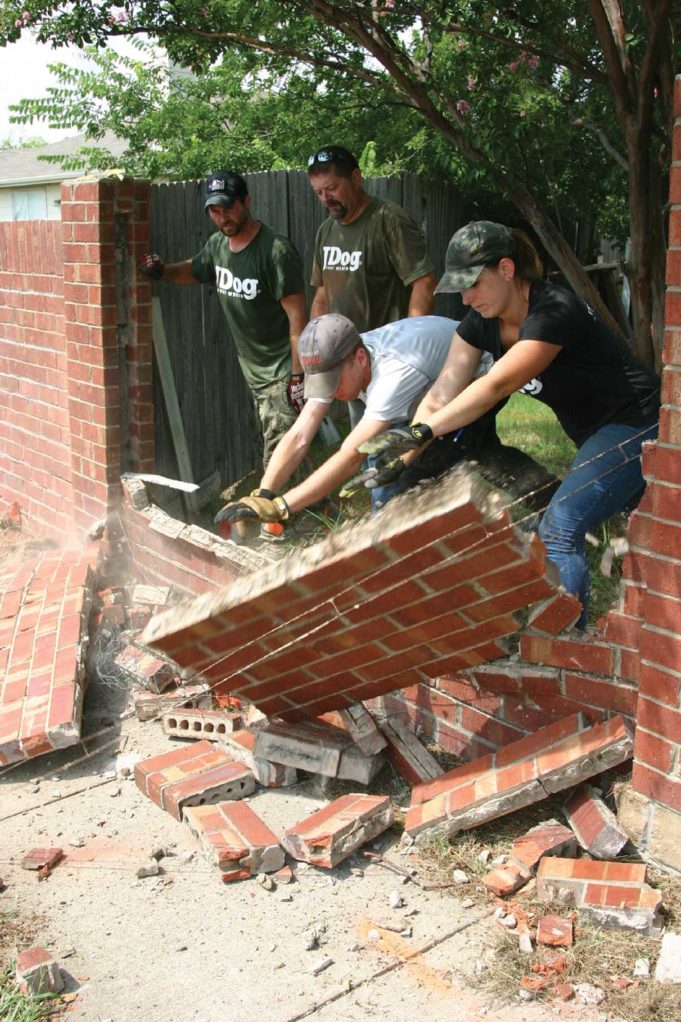West Fort Worth’s brick wall from hell is getting knocked down before it falls on somebody. Fort Worth officials came to a compromise with the majority of the 15 homeowners whose backyards are separated from Chapel Creek Boulevard by the tall red-brick monster that was built in 1998 and has been decaying in recent years.
In 2015, city officials blocked off portions of the adjacent sidewalk with yellow tape to keep people from walking beside the teetering fence. Code Compliance told homeowners they were responsible for knocking down the part of the structure that was on their properties, hauling off the debris, and rebuilding. Estimated cost for all that? At least $100,000 split up among the property owners depending on the sizes of their backyards.
Homeowner Jim Strachan received a $10,000 estimate from a contractor just to tear down and remove his portion of the wall, and that didn’t include replacement (“A Large Bill,” April 20, 2016). He is now refusing to pay any amount, saying city officials erred 19 years ago by granting a building permit. The builder used thick metal rebar in the columns, making them strong and sturdy when mixed with the concrete. The rest? Not so much.
“The walls are hazardous,” said Jaime Ortiz, co-owner with husband John Ortiz of JDog Junk Removal & Hauling. “We are able to push four feet of the wall down by hand. It just pulls right off. It is extremely unstable. The pillars are the only stable structures we have found. The rest of the brick fence has thin metal wire between the brick layers that’s rusted away, so that has deteriorated the stability.”
Neighborhood association members researched the long-ago construction and determined that the contractor who built the wall had long since retired and moved out of state.
So far, six property owners have hired JDog to knock down their sections, Ortiz said. She has provided estimates to two others and is awaiting their responses, she said.
The backyards span a four-block stretch between Chapin Road and Meadow Gate Drive in the Little Chapel Creek Addition.
Last week, Ortiz and three helpers were working on a property near Meadow Gate, pushing down several sections of the wall by hand. To smash the columns, the crew relied on jackhammers, sledgehammers, and brute force. Ortiz was charging $100 an hour and expected the job to be finished in about eight to 10 hours. Then a city crew hauled off the pile of old bricks and mortar at no cost to the property owner.
Ortiz said she would have charged far more than $1,000 to haul away the rubble.
“In regard to our service, the most costly portion is loading it onto our trailer and having to go dispose of it properly,” she said. “The labor, dump fees, cost of the equipment, insurance – all those expenses add up.”
Ortiz was tearing down the wall of a homeowner who agreed to be interviewed for this article but did not want to be identified. The homeowner said he took the city’s deal because of two factors: City officials agreed to bear the cost of the haul-off, and they also granted a variance that allows property owners to replace the brick structure with more typical – and much cheaper – wooden privacy fences.
“All this started moving forward when the city said, ‘OK, we will pick up the brick and haul it off,’ ” he said. “That was a big stopgap for a lot of us. You are talking about thousands of dollars for the demo and haul-off. I wouldn’t have been able to afford all that.”
He appreciated the city’s compromise and decided to spend a couple thousand bucks to knock down the wall and put up a wooden fence “just to get off the city’s radar,” he said.
The long wall was already built when the homeowner bought his new house in 2001.
The city cannot spend taxpayer money to repair a structure on private property, former City Councilmember Zim Zimmerman told the Weekly last year. His district had included the subdivision.
“I’m pretty sure now that anything a developer puts up is going to be inspected,” Zimmerman said. “Obviously, the [Little Chapel Creek] developer is long gone, and even if he was around he would deny anything was done wrong. The statute of limitations is probably way gone by.”
The unusual situation prompted JDog to offer its demo services at a cut-rate price, Ortiz said. JDog is a franchise business owned and operated by military veterans. Several of the affected homeowners are vets.
“We’re trying to do the work at a really reasonable price for these people because it seems kind of unfair,” she said.
Strachan, the homeowner who had received a $10,000 bid for removal and replacement, remains uninterested in hiring JDog or spending any money on the fence. City officials should pay since they allowed the wall to be built, he said.
“They put everything on me when they are the ones who are responsible,” he said.
He wrote a letter of complaint to Mayor Betsy Price a month ago, he said, but never received a response.
Property owners said they were informed by Code Compliance that those who refuse to pay for fence demolishing and replacement will have the work done for them, with the cost applied through property liens. In a situation like that, the money is submitted to the city once a property sells.
The city’s volunteering to haul off the debris does not necessarily set precedent for future situations involving decaying walls around subdivisions, a city spokesperson said. City officials have not stated there was any lax or questionable permitting and inspections of the Chapel Creek wall 20 years ago. But it appeared to some property owners that the obviously inferior wall helped win them some favors from City Hall.
Code Compliance Director Brandon Bennett said in an email that the agreement to haul away debris was done as a test case.
“Code Compliance, seeing the struggle of private parties trying to agree on a solution/shared costs/etc. of a failing wall along a right of way, offered a test case to see, if we helped with disposal, if that would get the private parties to agree on the other issues,” he said wrote. “Since it was a test case, we did not use a contactor or establish a policy for future services.”
Code Compliance staff is hauling the old bricks to a recycling plant using city equipment, he wrote.
“The city is not going to get into the private hauling business as general course of providing services,” Bennett wrote. “This was simply a test case just like other test cases we have done on waste carts, tree trimming, litter abatement, homeless camps, graffiti, etc.”
Reading between the lines, that sounds like he might be saying that city employees won’t be hauling off similar walls on private property that were built adequately but simply degraded over time.













Great article.